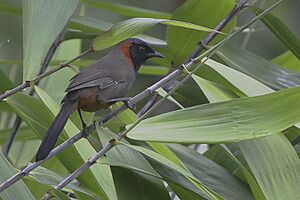Rufous-necked laughingthrush facts for kids
Quick facts for kids Rufous-necked laughingthrush |
|
|---|---|
 |
|
| From Mahananda Wildlife Sanctuary in West Bengal, India. | |
| Conservation status | |
| Scientific classification | |
| Synonyms | |
|
Ianthocincla ruficollis |
The rufous-necked laughingthrush (Pterorhinus ruficollis) is a type of bird that belongs to the laughingthrush family. You can find these birds in countries like Bangladesh, Bhutan, China, India, Myanmar, and Nepal. They love living in warm, wet forests, both in lowlands and in mountains. Even though they are quite common, not a lot of research has been done on them.
Contents
About the Rufous-necked Laughingthrush
The rufous-necked laughingthrush is not a thrush, but a type of babbler bird. It gets its name from the rusty, reddish-brown color around its neck. The rest of its body is mostly grey, and it has a black face.
These birds are about 22–27 centimetres (8.7–10.6 in) (around 9 to 11 inches) long. They weigh between 51–73 grams (1.8–2.6 oz) (about 1.8 to 2.6 ounces). This is roughly the weight of a few strawberries!
Because they don't migrate, these birds change their feathers very slowly. This means that young rufous-necked laughingthrushes look very similar to older ones. They also look a lot like the rufous-cheeked laughingthrush. However, these two species live in completely different areas.
Where Rufous-necked Laughingthrushes Live
You can find the rufous-necked laughingthrush in warm, wet forests. Their home range stretches from Nepal all the way to China, and down into Myanmar.
These birds are "non-migratory." This means they stay in the same place their whole lives. They don't fly to different areas for breeding or during different seasons. Some groups of these birds live in isolated spots in Nepal. This probably happened when the big mountain ranges in that area were formed.
The rufous-necked laughingthrush is common in all the places it lives. Because of this, it is listed as a species of "least concern" by the IUCN Red List. This means they are not currently in danger of disappearing.
Rufous-necked Laughingthrush Behavior
Bird Calls and Sounds
The rufous-necked laughingthrush makes a series of small chirping sounds. These calls seem to ramble on, almost like a mockingbird imitating other sounds. This is why they are called "laughingthrushes"—their calls can sound a bit like babbling or laughing!
They also have quick, sharp calls that are easy to recognize. You can often hear these calls, especially when many birds are together in a group looking for food.
What Rufous-necked Laughingthrushes Eat
These birds mostly eat insects. However, they have "generalist bills," which means they can eat many different kinds of food. They also enjoy eating seeds, molluscs (like snails), and berries. Because they can eat so many different things, it's usually easy for them to find food. This is different from birds that only eat one specific type of food.
Rufous-necked Laughingthrush Life Cycle
Scientists haven't studied the reproduction of rufous-necked laughingthrushes very much. However, it's thought that they reproduce in a similar way to other laughingthrush species.
They are very smart when it comes to their eggs. They are good at recognizing their own eggs. This makes it hard for "parasitic" birds, like cuckoos, to trick them. Cuckoos sometimes try to lay their eggs in another bird's nest. But the rufous-necked laughingthrush can spot eggs that don't look like theirs and remove them.
When it comes to mating, male and female rufous-necked laughingthrushes can be different sizes. This might be because females choose males that are better at defending their territory. So, being a certain size might have become important over time.
They build small, cup-shaped nests. These nests are compact and made from leaves and grasses. They typically breed from March to August.


